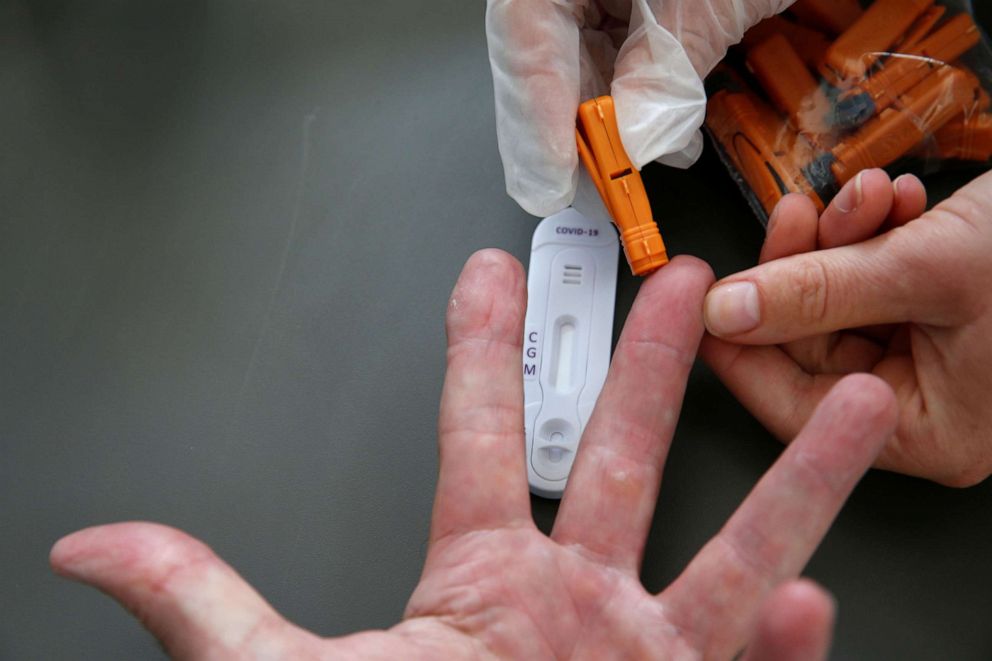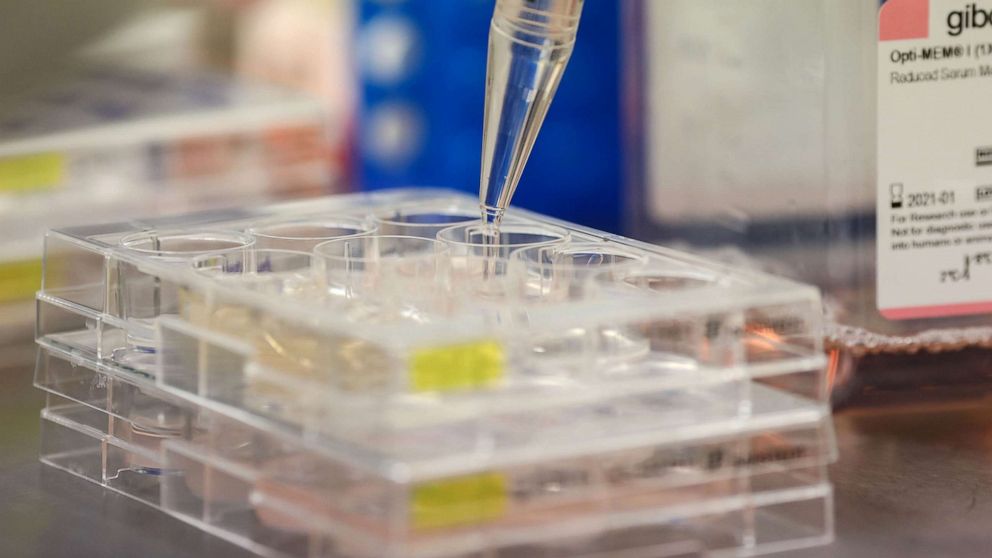Beyond the antibodies: How our immune system may protect us against COVID-19 infection
As the COVID-19 pandemic rages on and more people get infected and recover, scientists continue to learn about the body’s protective immune response against the virus.
Emerging evidence has suggested that COVID-19 antibodies -- proteins produced by the body’s immune system to fight infection and protect against future reinfection -- may start waning in as little as two months, raising questions about how long immunity may last and whether or not a person can get reinfected.
But experts say other defense mechanisms, such as the production and longevity of B-cells and T-cells, may also play critical roles in bolstering the body’s fight against the virus and protecting against future reinfection.
“The great thing about antibody is that it doesn't have to call in help. It’s there to immediately grab hold of the virus and neutralize it so it can’t get into your cells and stops infections from establishing,” said Dr. Erin Bromage, associate professor of biology at University of Massachusetts Dartmouth. “But if we are looking at a situation where antibodies are disappearing it doesn’t necessarily mean that we are not immune.”
According to Dr. Robert Glatter, emergency medicine physician at Lenox Hill Hospital Northwell Health, typical seasonal coronaviruses immunity is typically short-lived since infections recur in a seasonal fashion in the winter and fall. In the case of other related coronaviruses, scientists have found that antibodies only remained for about a year, he noted.
But there is a good chance that antibody production is not the only form of defense in protecting against future encounters with the virus.
Generally speaking, when our body encounters a foreign and potentially dangerous virus, it activates its innate immune response, which forms the first-line of defense against foreign pathogens.
But over our lifetime we also encounter more treacherous viruses that can get past our preliminary lines of defense and require a learned and more specific form of defense, otherwise known as an “adaptive immune response.”
It's this adaptive immune response that includes the production of specific virus-fighting antibodies. Antibodies are produced by a specific subtype of B-cells, another component of the adaptive immune system's smart defenses. B-cells can recognize particular pathogens, or foreign substances, that enter the body like the SARS-CoV-2 virus.

When a B-cell first recognizes its target virus, say SARS-CoV-2, it will start making copies of itself and in the process become even better at recognizing the incoming virus. Some of these B-cells will be deployed to fight the virus by producing antibodies while other B-cells known as memory B-cells will stay back and wait on the sidelines for a future encounter with the virus.
“Memory B-cells are trained on how to respond, so that the next time you actually get exposed to the virus, they will see it. They will quickly proliferate, they will change to secrete antibodies and neutralize that virus again,” said Bromage. “The only downside to memory B-cells is that they take a few days to really be effective.”
That small window when B-cells ramp up their defenses may be just enough time for the virus to successfully settle in and make people sick.
Because the novel coronavirus has only been with us for six months, scientists don't yet have a good understanding how effectively our bodies might develop and maintain these watchful guardians.
“We don't have enough data on memory B-cells in regards to this virus, but it wouldn't be unusual to expect that they are there and ready to respond the next time around,” Bromage added.
In addition to B-cells, our adaptive immune response also includes the production of T-cells. There are multiple types of T-cells, the two main types being helper and killer T-cells.
Helper T-cells overall play a supportive role, such as helping B-cells expedite the production of antibodies, whereas killer T-cells are more aggressive, actively searching for and destroying virus-infected cells.
The virus hides inside its host cell, making hundreds of copies of itself. Once the killer T-cell detects that the cell is in danger, the infected cell will begin a very controlled process of cell death, called apoptosis, which will destroy what is inside it without releasing the virus, so that the virus can no longer infect any other cells.
Recently published data has also suggested that infection and exposure to SARS-COV-2, among other types of coronaviruses, induces virus specific T-cell response in recovered patients. Researchers tested uninfected healthy individuals and found that some of these people had T-cells that may also provide protection against SARS-CoV-2, which may have been developed from previous exposure to other genetically similar seasonal coronaviruses.
Scientists also found that patients who recovered from the 2003 SARS outbreak still possessed memory T-cells, some of which may also be effective in fighting COVID-19. Although this preliminary data is promising, the duration and extent of potential immunity that may persist from this T-cell response is still unknown.
According to Bromage, T-cells might be a critical mechanism of defense when antibody response fades.
The distinct defense mechanism of these killer T-cells over antibodies is that they can actually “see what’s happening inside the cell and attack the virus when it’s hiding inside the cells,” said Bromage. Ultimately when you have all these immune system mechanisms at play -- including B-cells and T-cells working together -- you will have “fantastic clearance of the viral infection, but it doesn’t mean you need both to be immune.”
The most effective immune response includes activation of both B-cell producing antibodies -- which directly bind to the virus -- as well as T-cell activity that can destroy foreign invaders, according to Glatter.
Once the virus is eradicated from the body, the memory B and T-cells linger, on the lookout for another encounter with the virus. The amount of time they persist varies by virus but in some cases these cells may persist for an entire lifetime.
Added Bromage, “Previous coronavirus infections may generate helper and [killer] T-cells that may help in protecting against this particular coronavirus, which means that rather than having to train a whole new army of T-cells to respond, you already have an army trained and you jump straight in.”
Scientists still don’t have enough data on this new virus to understand how the body recovers and defends itself, but these answers will be key in determining which of the emerging COVID-19 vaccine candidates are most promising.
In a sense, vaccine developers are flying blind. They are attempting to coax the body to produce the "right" immune response without knowing exactly which response will effectively protect against infection.
“It's about the robustness and longevity of the response," explained Dr. Paul Offit, director of the Vaccine Education Center and an attending physician in the Division of Infectious Diseases at Children's Hospital of Philadelphia.
Some experts are investigating whether that protection may be short-lived or less effective if the vaccine does not successfully elicit a helper T-cell response along with neutralizing antibodies.
According to Glatter, “It’s unclear if the immunity produced by any candidate vaccine will be long-lasting. But the hope is that T-cell immunity will play a larger role in the overall response when large scale vaccination begins.”
The most recent results published by major pharmaceutical companies like Oxford-AstraZeneca, Moderna, Pfizer-BioNTech and Cansino Biologics are promising. While experts are excited, they continue to caution that the efficacy of these vaccines is still unknown and will only become clearer following Phase 3 trials.
Eden David, who studied neuroscience at Columbia University and is matriculating to Icahn School of Medicine at Mount Sinai later this year, is a member of the ABC News Medical Unit.




